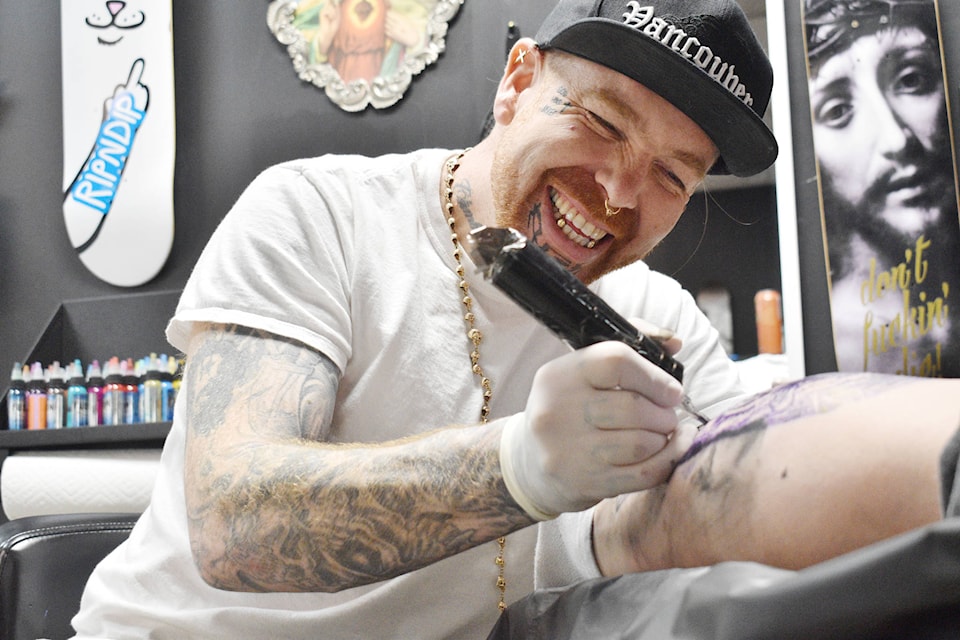Oliver Brown’s tattoo studio DivineInk moved into the Lakelse 4600 block of downtown Terrace last October at a time when business owners were complaining about the menace and disruption brought on by increasing drug addiction, and homelessness.
A month ago the block was a challenging place for shop owners owing to vandalism and drug use until one day anti-social behaviour mostly disappeared. Brown can take some credit for that.
He asked people on the street to leave as he termed it with a cheeky smile, “nicely,” following an altercation after one of his clients was harassed.
Brown hails from Vancouver’s infamous Downtown Eastside where he spent most of his formative years as a graffiti and tattoo artist – right in the “belly of the beast,” as he puts it.
No stranger to drug addiction, homelessness and prison life in his youth, Brown says he always treats people living on the street with respect and dignity.
But when disrespect creeps in, and it affects his clients or friends or family, that is when it’s time for some “tough love.”
“I’m not a snowflake, and I’m not going to be intimidated…I’ll buy you pizza and coffee but when I ask you to leave, there’s no option, you leave,” he says about his dealings with people exhibiting antisocial behaviour.
A decade after he quit doing drugs, he says he has witnessed a change in the society where actions seem to have little or no consequences especially when it comes to drug use. He feels there is an enabling attitude that causes more harm than good.
“When I was an addict, if you got busted using drugs you got arrested and went to jail. The cops can’t do that now…drug addicts are labelled as infirm, with a disease and not able to make good decisions.”
He doesn’t buy that. “I don’t think that addiction is a disease – it is a compound of bad choices.”
“It’s hard to get out but with good support the whole thing can be turned around,” he says – “I am a living proof of it.”
A tattoo near his temple reads “God was here”– a reminder of divine intervention in his life and from where his studio derived its name.
Brown has been a tattoo artist for 20 years, long enough to see the industry evolve.
After the 9/11 World Trade Centre attack, he lost his job as an arborist after his New York-based employer shut shop.
Brown descended into a downward spiral and ended an addict out on the streets before his heavy involvement in graffiti art set him on a path to recovery.
Back when he started as a tattoo artist, it was not a prestigious profession, he says. “When I told my mum I was going to be a tattoo artist, I might as well have told her I’m going to be a heroin addict.”
Since then, he made a name for himself as a street shop artist specializing in black and grey realism.
The easiest way to measure his reputation is by the long list of people who are willing to wait for months (sometimes a year) to get an appointment.
For Brown, the moment for himself and his art boiled down to when he heard his dad say – for the first time – that he was proud of him. “My parents believed that tattooing was a byproduct of my drug addiction…so they were like ‘let him do it, he doesn’t fit anywhere else, at least he’s not in jail anymore.’”
The perception of others also changed as Brown’s reputation grew.
He’s not in it for the fame, he says. There’s a tattoo on his body which supports this claim – it reads “f*** fame.”
“Fame made people get into the tattoo business for the wrong reasons and it wasn’t based in art- they wanted to become artists for the popularity, the money, etc.”
For him it’s all about the art – “I can’t remove art from my life, I wouldn’t fit anywhere else.”
He reminisces as he works on a cover-up project, intricately turning strawberries previously tattooed on a client’s arms into aliens – a reminder that there’s no place for artistic ego when a client comes in and says exactly what they want.
“I draw on people for money, that’s it. If I take it any further than that there’s all kind of weird emotional attachment and me not wanting to do stuff and not agreeing with the client. My job is to apply a tattoo on their body and make sure they get the best tattoo they want.”
Brown adopted this ethos after one of his mentors gave him a reality check mid-career, when he got disenchanted by the trends with which he didn’t agree.
Brown calls it his biggest growth spur as a tattoo artist, saving him from being blinded by his own ego and thinking he is too good to do what the client wants.
There has been a hundred-fold increase in the number of people wanting to get tattoos in the past couple of decades and despite all the changes in the industry, Brown says he’s the same person he was when he started.
In the 1990s and 2000s, tattoo studios became a safe haven for outcasts, outlaws, rebels, pariahs, he says, where no one cared about the other’s race, creed or religion and in many respects, the aura of a studio being a cool place to hang out remains.
“There is a definition of universalism in a tattoo shop that you can’t find anywhere else,” Brown adds.
